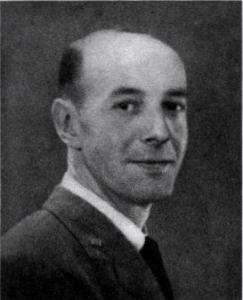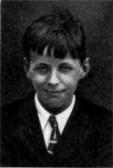
|

|
| Pilot Officer Patrick Claud COTTER (130513) | |
|
50 Squadron Royal Air Force Date of birth: 27th November 1909 Date of death: 17th April 1943 Killed in action aged 33 Commemorated on the Runnymede Memorial Panel 131 |

|
| Patrick Claud Cotter was born on the 27th of November 1909 the eldest son of the Reverend Claud Rutledge Cotter, Vicar of Chirton, and Beatrice Eleanor (nee Cotter) Cotter of the Vicarage in Lewisham. He was christened by his father at All Hallows Church, Poplar on the 11th of January 1910. He was educated at Oxford Preparatory School (Dragon School) from September 1917 to July 1923 where he was a noted actor and fine cricketer, although he did not play for the Cricket XI. He was a Lector in 1922 and 1923 and was appointed as a Prefect in 1923. He won a Reading Prize and a General Paper Prize as well as sharing the Hugh Sidgwick Literature Prize. He won a scholarship to Lancing College where he was in Sandersons House from September 1923 to July 1928. He was a Corporal in the Officer Training Corps, achieving Certificate A in 1926, and was Editor of the Lancing Magazine in 1927. He gained his School Certificate in 1925. He was also President of the Lancing College Debating Society in 1927 and was appointed as a House Captain, Prefect and as Head of House in 1927. He won a History Scholarship to Hertford College Oxford in 1928 and achieved a BA there in 1931 and, during his time there, he spent a summer teaching at his old prep school. On leaving university he spent a year teaching at Marlborough College before going on to Wells Theological College in 1932. He became Deacon of St Mary’s Church in Hendon for a year from 1933. He was then appointed as Sub-Warden of Student Movement House. He was married in Norfolk in 1937 to Helen Mary (nee Peacock) of South Runcton, King’s Lynn in Norfolk and they had two children. He was appointed as an Inspector in the Police Court Probation Branch of the Home Office on the 1st of June 1937 where he was an Inspector of Probation Officers and was in charge of the Home Officer Training Scheme. On the outbreak of war he was seconded to the Ministry of Home Security where he visited areas which had been bombed and reported his findings back to the Ministry. He joined the Royal Air Force Volunteer Reserve in February 1942 and rose to the rank of Leading Aircraftman before being commissioned as a Pilot Officer on the 27th of October 1942. He completed his training as a navigator in November 1942 and was later posted to 50 Squadron, Royal Air Force. On the night of the 16th/17th of April 1943 197 Lancasters and 130 Halifaxes were despatched by Bomber Command for an attack on the Skoda factory at Pilsen. In the event, despite the bright moonlight, the bomber stream wrongly identified a large asylum building some 7 miles away from the actual target and killed some 200 German soldiers who were stationed in a nearby barracks when they dropped their bombs. Patrick Cotter and his crew took off from RAF Skellingthorpe at 9.43pm on the 16th of April 1943 in Lancaster Mk III ED784 VN-N for the operation. It was his first operational mission and he was flying as second navigator in order to gain experience. At 11.45pm the aircraft was flying at 10,000 feet and was some twenty miles to the west of Saarbrucken when the Flight Engineer spotted a Messerschmitt Bf 110 night fighter on the starboard bow at a range of 100 yards. He warned the gunners and they watched the enemy aircraft as it turned and approached them from behind at a range of about 600 yards. While the Lancaster pilot weaved his aircraft from side to side the enemy aircraft had closed to a range of 250 yards when the Lancaster's rear gunner opened fire on it with a three to four second burst. Tracer bullets were seen to strike the Messerschmitt's port engine and it was seen to dive towards the ground with the engine on fire. Before the first night fighter had hit the ground another was spotted when the mid upper gunner saw tracer bullets coming towards the bomber from a second Messerschmitt Bf 110 which was firing at them from a range of around 300 yards. The mid upper gunner shouted to the pilot to make a diving turn to port and, as this was done, he opened fire with a short burst which is not thought to have damaged the enemy aircraft. As they dived the night fighter was lost to sight. During these engagements the mid upper gunner fired around 20 rounds of ammunition while the rear gunner had fired around 300. They continued towards the target where they were caught in a cone of searchlights and hit by anti aircraft fire which caused significant damage to the airframe. At around 4am on the 17th of April they were forced to ditch in the Channel some five miles off the French coast near Berck-sur-Mer. The crew reached the dingy but it was damaged and was unable to accommodate all of them. The pilot, Henry Elderfield, was last seen swimming for the French coast in order to get help. The crew members who died were:- Flying Officer Henry Elderfield (Pilot) Pilot Officer Patrick Claud Cotter (2nd Navigator) Sergeant Harold Hinchcliffe (Air Bomber) The following crew members survived and were rescued by a motor torpedo boat at 2am on the 18th of April:- Sergeant R. Chambers (Flight Engineer) Sergeant J.M. Laing (Navigator) Sergeant R.S. Harman (Wireless Operator/Air Gunner) Sergeant John "Wally" Hammond (Mid Upper Gunner) Sergeant H. Webster (Rear Gunner) His father wrote:- "Pat had an unique gift for mixing with people of all types, which had its origin perhaps in the different types of parishes I lived in, and he never needed to be other than just himself, with his innate love of his fellow-men. He kept in touch with his East End friends as much as with his many other friends, right up to the end." Arthur Mayhew, a friend from the Dragon School wrote:- " ... It was a fine ending to a life that was full of heroism from the day when, at his own urgent request, he was released from a safe job for war service and training of an arduous kind, which must have imposed on a man of his temperament a terribly heavy strain."- Former Lancing master, J.M.G. Blakinson (1927 to 1931), wrote:- "It is as a friend of fifteen years' standing rather than as the schoolmaster who taught him for one year at Lancing that I attempt this brief appreciation of Pat Cotter. But, of course, no short sketch could do justice to that warm and scintillating personality. In the first place, Pat was a clever man: he could win scholarships, he could make brilliant speeches; his literary work, though he never cared to publish it, has remarkable qualities; his letters and his conversation dazzled; when, last year, he felt the call to active service, he was doing outstanding work at the Home Office; and then, after a life concerned with a very different subject matter, he could distinguish himself in R.A.F. examinations. These qualities of mind were balanced by an extraordinary warmth of heart. I have known no man with greater social gifts: "I shall never work in better company," he wrote with characteristic gusto in one of his last letters from the Air Force. But though he never missed an opportunity of a fresh contact-and he was equally at home with a Cockney docker, a country gentleman, or a Russian theologian-such contacts were never merely superficial; for with a broad love of the human race he combined a discriminating and inexhaustibly sympathetic knowledge of human beings. Through this double genius of heart and intellect Pat could, without effort, have won many sorts of popular fame. His greatness lay in his renunciation of so smooth a path. This is not the place to describe a spiritual career in which there were many storms and torments, but where truth was the constant goal; indeed the wisdom and serenity to which in recent years he had attained compels reticence on the troubles that went before. But the death in action which was to be the destiny of this least warlike of men will perhaps be seen by those who knew, loved, and admired him as a not unfitting conclusion." He is commemorated on the war memorial at Runcton Holmes and on the memorial at the Dragon School. |
|
 | |
| Sandersons House |
Back